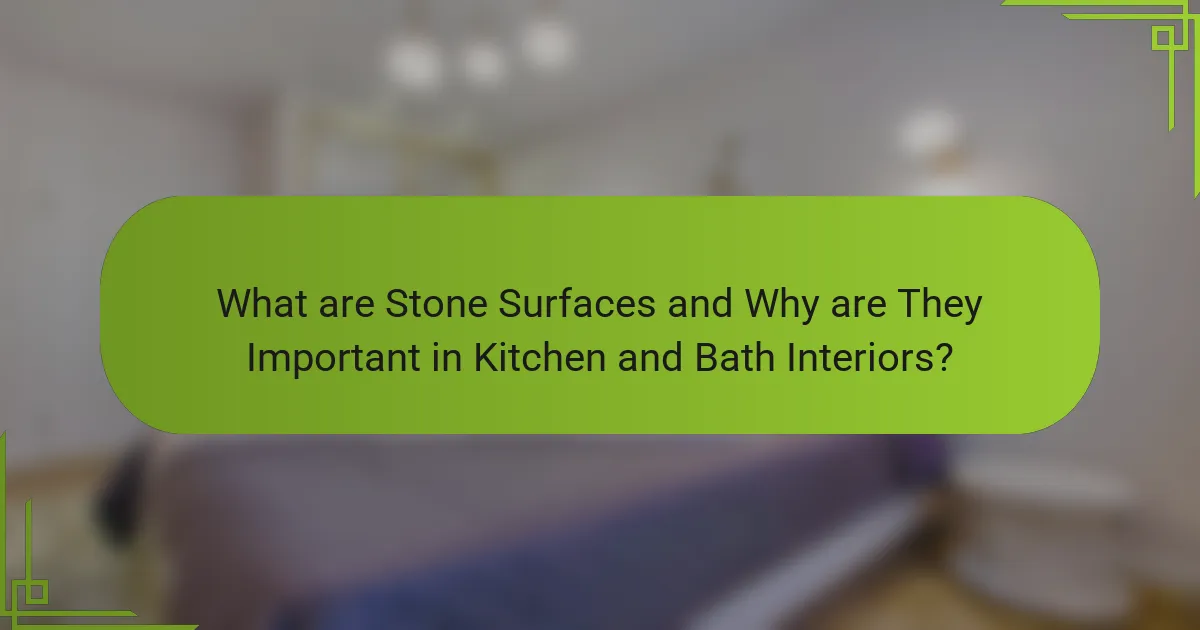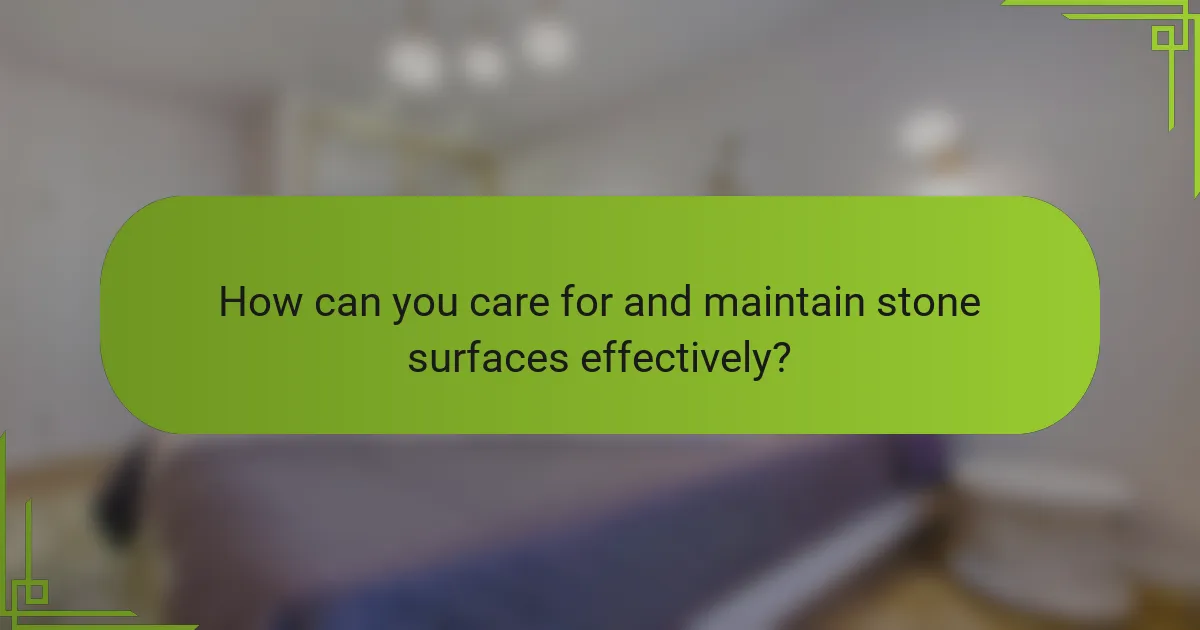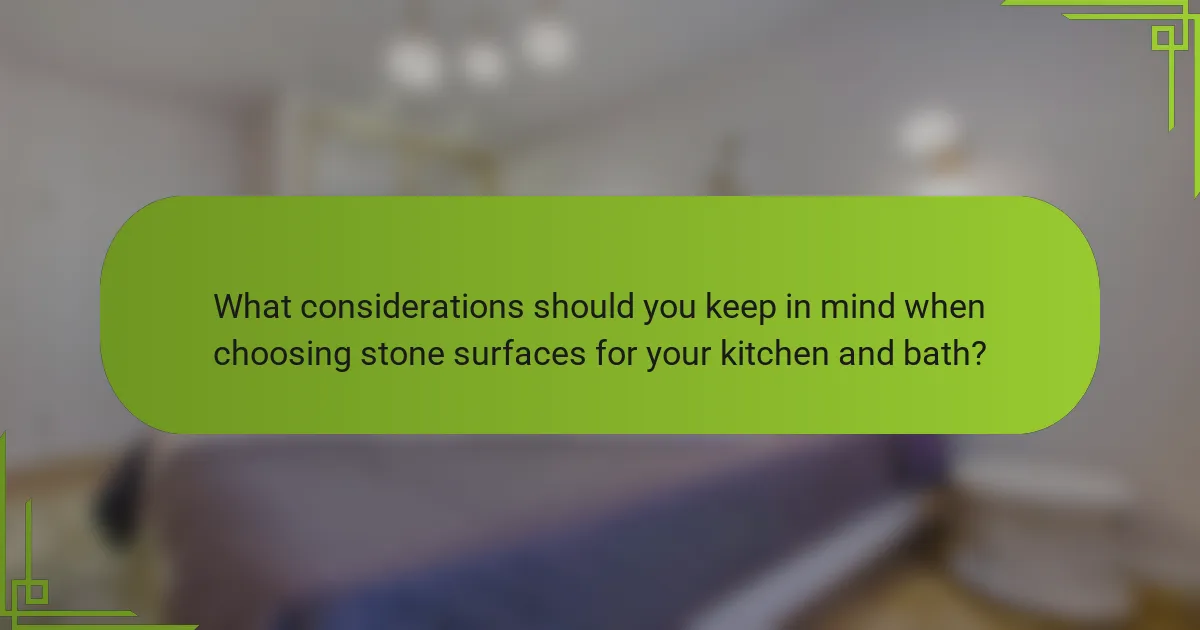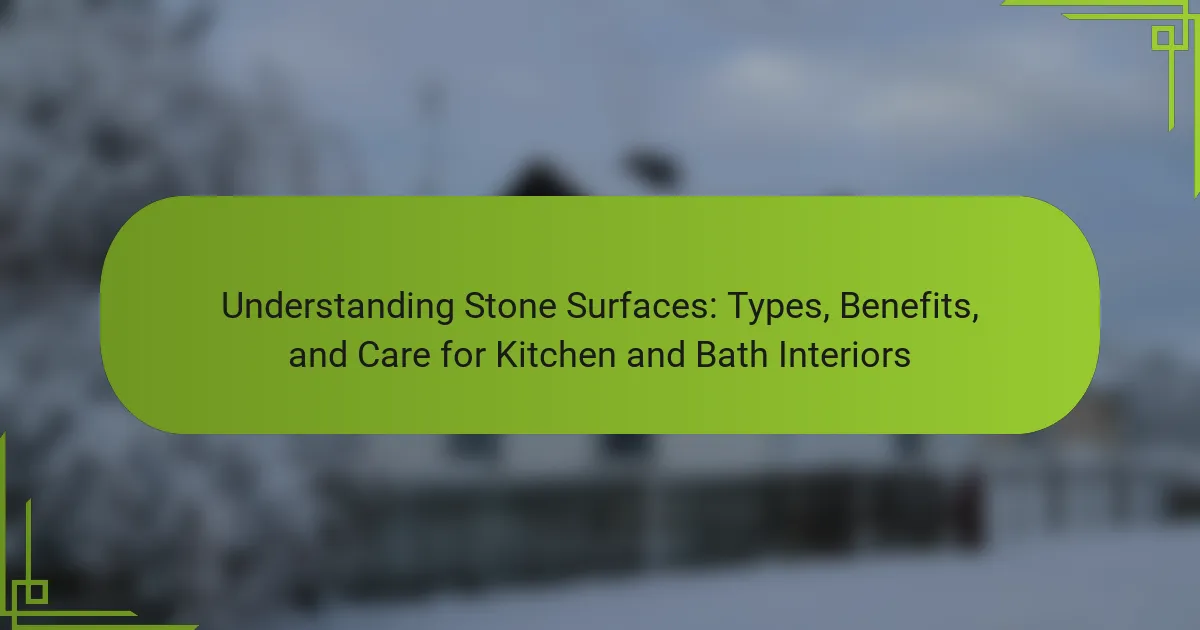
What are Stone Surfaces and Why are They Important in Kitchen and Bath Interiors?
Stone surfaces are solid materials made from natural stone, commonly used in kitchen and bath interiors. These surfaces include granite, marble, quartz, and soapstone. They are valued for their durability, aesthetic appeal, and resistance to heat and moisture. Stone surfaces can withstand heavy use and are less prone to scratches and stains compared to other materials. Their natural beauty enhances the overall design of kitchens and bathrooms. Additionally, stone surfaces can increase property value due to their luxurious appearance. The variety of colors and patterns available allows for personalized design choices. Overall, stone surfaces play a significant role in both functionality and style in these spaces.
What types of stone surfaces are commonly used in kitchen and bath interiors?
Common types of stone surfaces used in kitchen and bath interiors include granite, marble, quartz, and soapstone. Granite is highly durable and resistant to scratches. It comes in various colors and patterns. Marble offers a classic, elegant look but is more porous and can stain easily. Quartz is engineered, combining natural stone with resins, providing a non-porous surface. Soapstone is heat-resistant and has a unique, soft feel. Each type has distinct characteristics that influence its suitability for different applications in kitchens and bathrooms.
What are the characteristics of granite as a stone surface?
Granite is a durable and versatile stone surface. It is known for its hardness, which makes it resistant to scratches and heat. Granite surfaces are also non-porous when sealed properly, preventing stains from liquids. The aesthetic appeal of granite comes from its unique patterns and colors, formed by mineral composition. Additionally, granite is easy to maintain, requiring only regular cleaning with mild soap and water. Its longevity is supported by its ability to withstand wear over time. Overall, granite combines functionality with beauty, making it a popular choice for kitchens and bathrooms.
How does marble differ from other stone surfaces?
Marble differs from other stone surfaces primarily due to its unique composition and aesthetic appeal. It is a metamorphic rock formed from limestone under heat and pressure, giving it distinctive veining and color variations. Unlike granite, which is an igneous rock, marble is softer and more porous. This porosity makes marble more susceptible to staining and scratching compared to harder stones. Additionally, marble has a classic, elegant look that is often associated with luxury, making it a popular choice for countertops and flooring. Its ability to be polished to a high shine enhances its visual appeal. Overall, these characteristics set marble apart from other stone surfaces in terms of both functionality and design.
What unique properties does quartzite offer for interiors?
Quartzite offers exceptional durability and resistance to heat and scratches for interiors. This natural stone is formed from sandstone and undergoes high pressure and temperature, resulting in a dense and hard surface. Its low porosity makes it less susceptible to staining compared to other materials. Quartzite is available in various colors and patterns, providing aesthetic versatility for interior design. Additionally, it requires minimal maintenance, making it a practical choice for high-traffic areas. The unique crystalline structure of quartzite also contributes to its distinctive appearance and strength. These properties make quartzite an ideal option for kitchen countertops and bathroom surfaces.
What benefits do stone surfaces provide in kitchen and bath settings?
Stone surfaces provide durability and aesthetic appeal in kitchen and bath settings. They resist scratches, heat, and moisture, making them ideal for high-traffic areas. Stone surfaces, such as granite and quartz, are non-porous, which helps prevent bacterial growth. This feature is crucial for maintaining hygiene in food preparation and personal care spaces. Additionally, stone surfaces are available in various colors and patterns, enhancing the overall design. The natural beauty of stone can increase property value. According to the National Association of Realtors, homes with stone countertops sell for higher prices. Overall, stone surfaces combine functionality with elegance in kitchen and bath environments.
Why are stone surfaces considered durable and long-lasting?
Stone surfaces are considered durable and long-lasting due to their natural hardness and resistance to wear. These surfaces are composed of minerals that provide strength, such as granite and quartz. Their density makes them less susceptible to scratches and dents. Stone surfaces also resist heat and moisture, which prevents warping or damage over time. Additionally, they require minimal maintenance, contributing to their longevity. Research indicates that granite countertops can last over 100 years with proper care. Their ability to withstand heavy use makes them ideal for kitchens and bathrooms.
How do stone surfaces enhance the aesthetic appeal of interiors?
Stone surfaces enhance the aesthetic appeal of interiors through their natural beauty and texture. They provide a timeless elegance that complements various design styles. The unique patterns and colors of stone create visual interest in spaces. Natural stone, such as granite or marble, adds luxury and sophistication. These surfaces can serve as focal points in rooms, drawing attention and admiration. Additionally, stone surfaces reflect light, enhancing the overall brightness of interiors. Their durability ensures that they maintain their appearance over time, contributing to long-term aesthetic value. Studies show that natural materials like stone positively influence mood and perception of space.
What are the environmental benefits of using natural stone?
Natural stone offers significant environmental benefits. It is a sustainable material, as it is sourced directly from the earth. Natural stone requires minimal processing compared to synthetic materials. This reduces energy consumption and carbon emissions during production. Additionally, natural stone is durable and long-lasting. Its longevity means less frequent replacement, leading to reduced waste. Natural stone also has a low environmental impact during its lifecycle. It can be recycled or repurposed at the end of its use. Furthermore, natural stone does not emit harmful chemicals. This contributes to healthier indoor air quality.

How can you care for and maintain stone surfaces effectively?
To care for and maintain stone surfaces effectively, regularly clean them with a pH-balanced stone cleaner. Avoid acidic or abrasive cleaners that can damage the surface. Use a soft cloth or sponge to prevent scratching. Seal the stone surfaces every six to twelve months to protect against stains and moisture. Wipe up spills immediately to prevent staining. For tough stains, use a poultice specifically designed for stone. Regularly check for cracks or chips and repair them promptly to maintain integrity. Following these practices can significantly extend the life of stone surfaces.
What are the best cleaning practices for stone surfaces?
The best cleaning practices for stone surfaces include using pH-balanced cleaners and avoiding acidic substances. Stone surfaces can be sensitive to harsh chemicals. Regular sweeping or dusting removes dirt and debris. Use a soft cloth or sponge for application. Rinse with clean water after cleaning to remove residue. Dry the surface with a microfiber cloth to prevent water spots. Sealing stone surfaces periodically enhances their durability and resistance to stains. According to the Marble Institute of America, proper maintenance can extend the life of stone surfaces significantly.
What products should be avoided when cleaning stone surfaces?
Avoid acidic cleaners when cleaning stone surfaces. Acidic substances can damage the finish and integrity of the stone. Products like vinegar, lemon juice, and commercial bathroom cleaners often contain acids. These acids can etch or dull the surface of natural stones like marble and granite. Alkaline cleaners should also be avoided, as they can cause discoloration. Bleach is harmful as well, leading to stains and weakening the stone. Abrasive scrubbers can scratch the surface, compromising its appearance. Always use pH-balanced cleaners specifically designed for stone surfaces to ensure safety and longevity.
How often should stone surfaces be sealed or treated?
Stone surfaces should be sealed or treated every one to three years. The frequency depends on the type of stone and its exposure to elements. For example, granite may require sealing every one to two years, while marble may need it more frequently due to its porous nature. Regular sealing protects against stains and moisture damage. Additionally, high-traffic areas may necessitate more frequent treatment. Following manufacturer recommendations can ensure optimal care.
What common issues can arise with stone surfaces and how can they be resolved?
Common issues with stone surfaces include staining, scratching, and etching. Staining occurs when liquids penetrate the stone. To resolve this, clean spills immediately and use a stone sealer. Scratching happens due to abrasive materials or heavy objects. To fix scratches, use a polishing compound designed for the stone type. Etching results from acidic substances reacting with the stone. To address etching, buff the area with a fine-grit sandpaper or a stone polishing pad. Regular maintenance helps prevent these issues. Proper cleaning products and techniques are essential for preserving stone surfaces.
How can stains be effectively removed from stone surfaces?
To effectively remove stains from stone surfaces, start by identifying the type of stain. Common stains include oil, water, and organic materials. For oil-based stains, use a poultice made of baking soda and water. Apply it to the stain and cover with plastic wrap for 24 hours. For water stains, a mixture of equal parts vinegar and water can be used. Dab the solution on the stain and rinse with clean water. Organic stains, like those from food, can be treated with hydrogen peroxide. Apply it directly to the stain and let it sit for 10-15 minutes before rinsing. Always test any cleaning solution on a small, inconspicuous area first. Regular sealing of stone surfaces can help prevent future stains.
What steps should be taken to repair chips or cracks in stone surfaces?
To repair chips or cracks in stone surfaces, first clean the area thoroughly. Use a soft cloth and a mild detergent to remove dirt and debris. Next, assess the damage to determine the repair method. For small chips, use a stone filler that matches the stone color. Apply the filler using a putty knife and smooth it out. For larger cracks, consider using an epoxy resin for a stronger bond. Mix the epoxy according to the manufacturer’s instructions and apply it into the crack. Allow the filler or epoxy to cure as specified. Finally, polish the repaired area to blend it with the surrounding stone. Regular maintenance can help prevent future damage.

What considerations should you keep in mind when choosing stone surfaces for your kitchen and bath?
When choosing stone surfaces for your kitchen and bath, consider durability, maintenance, and aesthetics. Durability is crucial as surfaces must withstand daily wear and tear. For example, granite is highly durable and resistant to scratches. Maintenance requirements vary; some stones need sealing to prevent stains. Aesthetic appeal is also important; select colors and patterns that complement your design. Cost is another factor; natural stones can be more expensive than synthetic options. Finally, consider the compatibility of the stone with your overall interior design.
How do different stone types impact the overall functionality of a space?
Different stone types significantly impact the overall functionality of a space. Each stone type has unique characteristics that influence durability, maintenance, and aesthetic appeal. For example, granite is highly durable and resistant to scratches and heat. This makes it ideal for kitchen countertops. Marble, while beautiful, is more porous and prone to staining, which may limit its use in high-traffic areas. Limestone offers a softer appearance but can be less durable and more susceptible to damage from acidic substances. Quartzite provides a balance of beauty and strength, making it suitable for both kitchens and bathrooms. The choice of stone type affects not only the visual aspect but also the practical usability of the space. Therefore, understanding the specific properties of each stone type is crucial for optimizing functionality in interior design.
What factors should be considered regarding heat resistance in stone surfaces?
Heat resistance in stone surfaces depends on several factors. These factors include the type of stone, its mineral composition, and density. Granite, for example, has high heat resistance due to its dense structure and mineral content. Marble, while beautiful, is less heat resistant and can be damaged by high temperatures.
The finish of the stone also plays a role. Polished surfaces may show heat damage more than honed surfaces. Additionally, the presence of sealants can affect heat resistance. Some sealants may degrade under high heat, while others provide additional protection.
Environmental conditions, such as temperature fluctuations, can impact the longevity of heat resistance in stone surfaces. Regular maintenance is crucial to preserve heat resistance. Proper care can help prevent heat-related damage over time.
How does the weight of stone surfaces affect installation choices?
The weight of stone surfaces significantly influences installation choices. Heavier stones require more robust support structures. This often leads to the need for reinforced cabinetry or flooring. Installation methods may also vary based on weight. For example, heavier stones may necessitate professional installation to ensure safety and durability. Additionally, weight impacts transportation logistics and handling during installation. Proper planning is essential to accommodate the weight of the stone. This ensures that the surface remains stable and functional over time.
What are the best practices for selecting the right stone surface for your needs?
Identify your primary use for the stone surface. Consider durability, maintenance, and aesthetic appeal. Research different stone types like granite, marble, and quartz. Evaluate their characteristics, such as porosity and resistance to stains. Consider the environment where the stone will be installed. Indoor surfaces may require different properties than outdoor ones. Assess your budget, as prices can vary significantly among stone types. Consult with a professional to ensure proper installation and care recommendations. This approach ensures a stone surface that meets your functional and aesthetic needs.
How can you ensure color and pattern consistency when selecting stone surfaces?
To ensure color and pattern consistency when selecting stone surfaces, always request samples from suppliers. Compare these samples under the same lighting conditions. This practice helps in identifying variations in color and pattern. Additionally, consider the stone’s origin. Stones from the same quarry often exhibit more consistent characteristics. Look for certification or documentation from the supplier regarding the stone’s batch. This documentation can provide insights into potential color variations. Lastly, consult with a professional installer. Their expertise can guide you in achieving a cohesive look across your surfaces.
What budget considerations should be factored in when choosing stone surfaces?
When choosing stone surfaces, several budget considerations should be factored in. First, the cost of the stone itself varies significantly by type. For instance, granite typically ranges from $40 to $100 per square foot, while marble can be $50 to $150 per square foot. Second, installation costs must be considered. Professional installation can add $30 to $100 per square foot to the overall budget. Third, maintenance expenses should be evaluated. Some stones require regular sealing, which may incur additional costs over time. Fourth, the thickness of the stone can influence price; thicker slabs generally cost more. Lastly, shipping and handling fees may apply, especially for imported stones. These factors collectively impact the total budget for stone surfaces.
What practical tips can help you maximize the benefits of stone surfaces in your kitchen and bath?
To maximize the benefits of stone surfaces in your kitchen and bath, regularly clean and maintain them. Use a pH-balanced cleaner to avoid damaging the stone. Seal the surfaces periodically to protect against stains and moisture. Always use cutting boards and trivets to prevent scratches and heat damage. Avoid acidic substances that can etch the stone, such as lemon juice and vinegar. Implement a daily cleaning routine to keep surfaces looking pristine. Ensure proper ventilation to prevent moisture buildup, which can lead to mold. Regularly inspect for cracks or chips and address them promptly. These practices enhance the durability and appearance of stone surfaces.
Stone surfaces, including granite, marble, quartz, and soapstone, are essential materials in kitchen and bath interiors due to their durability, aesthetic appeal, and resistance to heat and moisture. This article explores the various types of stone surfaces, their unique characteristics, and the benefits they provide, such as enhancing property value and hygiene. Additionally, it covers maintenance practices, common issues, and considerations for selecting the right stone surface for specific needs, ensuring optimal functionality and design in these spaces.
